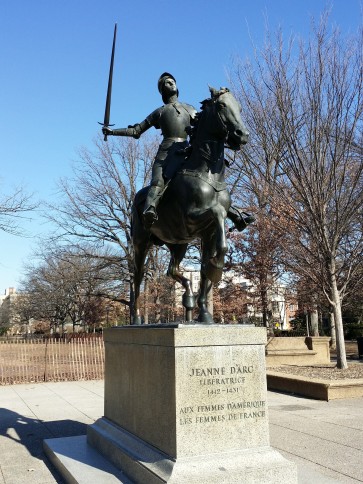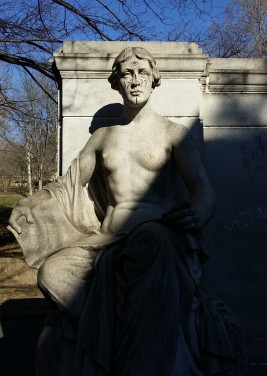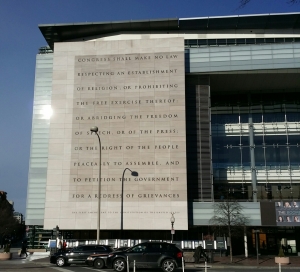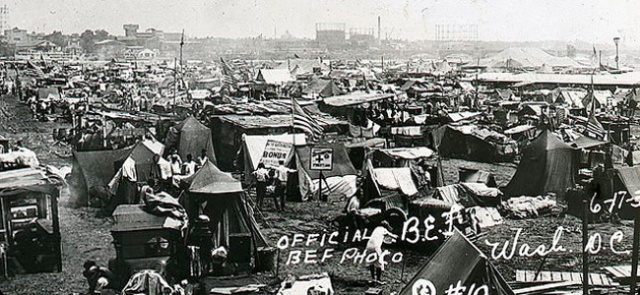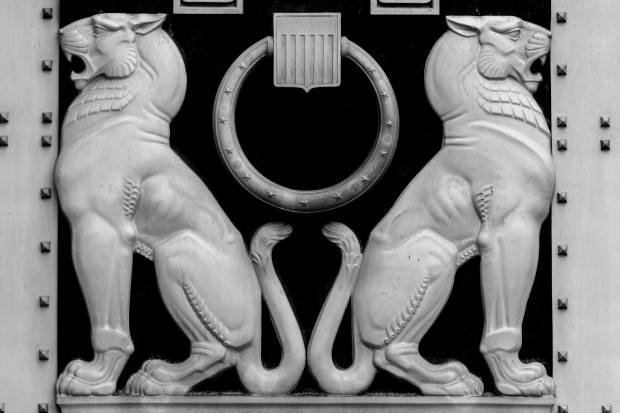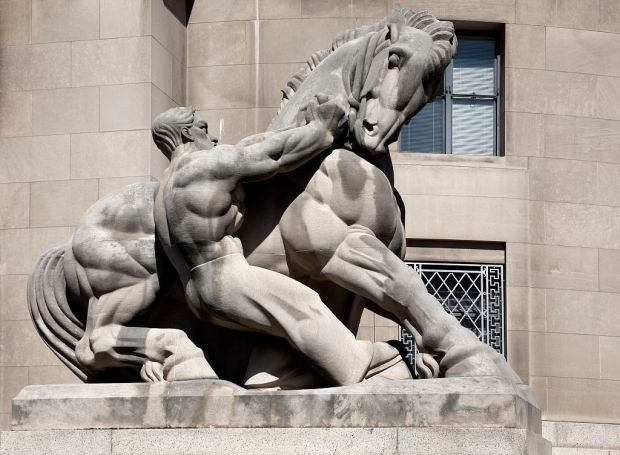I have a real soft spot for 16th Street NW. Drive up from the White House to the Maryland border, and you’ll see every kind of American architectural grandeur you ever dreamed of: fancy hotels; Deco and other modern condos carved from former residential hotels; churches and temples of every stripe, including some of the cahrazy ornate Scottish Rite variety; a bunch of embassies; and mini-mansions, regular mansions, and massive mansions. But my favorite thing of all on 16th Street is Meridian Hill Park, a beautifully landscaped, Italianate, be-statued park that starts at the end of the Alphabet Streets and ends at Euclid in Northwest DC.

The famous cascading fountain at Meridian Hill Park, bone dry, because it’s winter. But isn’t it pretty?
A note about Washington’s street plan: you can tell how far north you are from downtown by how many syllables are in the non-diagonal street names. When the alphabet runs out (A-W: no J, because Latin), you get Adams, Belmont, Chapin, etc., until you’re waaaaay up near the Maryland border at Whittier. Numbered streets get higher the further east or west you are from North Capitol Street. All this to say that if you find yourself on 34th St. and Macomb NW somehow, you’re going to have to take the Metro or a cab to meet back up with your friends.
Anyway, when I lived in the neighborhood, I knew the park as “Malcom X Park” (or “Needle Park,” because it wasn’t particularly safe to be there unless you wanted drugs and surely not then) and remember being surprised to see a seated statue of President Buchanan when I first went in. Buchanan: that old doughface who shrugged at the Dred Scott decision, saying “Waaayll, the Supreme Court knows what’s best. Who am I to judge?” or something like that. An anachronistic relic in a park that served a predominately African-American neighborhood and the location of many a civil rights protest: Angela Davis herself claimed the park for Malcolm X at a rally there in 1969.
It wasn’t until after I left the neighborhood that I learned the park’s official name and only just a few weeks ago, discovered that the meridian for which it is so named was 16th Street: once the prime meridian for the United States — or one of four such meridians, which makes very little sense to me. Meridian Hill was the name given the tract of land purchased by War of 1812 veteran, David Porter, who built himself a nice mansion near the meridian marker at the top of the hill. The view is great, in fact: I watched my first DC Fourth of July fireworks burst over the National Mall from a relatively uncrowded vantage point on a high wall there with some neighbors; thereby avoiding having to actually go downtown and sit with five million tourists so very far from my beloved private bathroom.
John Quincy Adams moved into Porter’s mansion when he left the presidency and the grounds were open to the public until the advent of the Civil War, when Union troops bivouacked there for the duration (see excellent view above). The mansion burned down at some point, and the grounds were subdivided into residences purchased by mainly African-American families, living as they were in what were the outskirts of town.
Enter Mary Foote Henderson, wife of Senator John B. Henderson, Republican from the (slave) state of Missouri (1862-1869), who introduced the 13th Amendment to the Constitution — the one that abolished slavery. Again: Buchanan? Mrs. Henderson was a tremendously entrepreneurial, real-estate-savvy woman. She and her husband bought up a whole mess of lots around Meridian Hill park and beyond. They built their very own castle on Sixteenth Street (I’m spelling it out because it’s a goddamned castle) and Mrs. Henderson began to lobby congress to convert the land (across the street) into a proper public park, filled with fountains and statues and beautifully landscaped walkways.

Henderson/Boundary Castle as seen from the base of unfinished Meridian Hill Park http://www.streetsofwashington.com/2011/07/iron-willed-empress-of-meridian-hill.html

A couple hundred condos now stand on the former location of Henderson Castle. All that is left is the retaining wall. http://www.streetsofwashington.com/2011/07/iron-willed-empress-of-meridian-hill.html
Mary Foote Henderson also envisioned 16th Street as a grand avenue on which to build embassies and stately homes to flank the park. The embassies would be constructed as a natural, symbolic extension northward from the White House on land that coincidentally and conveniently was owned by the Hendersons. Although she only managed to get a few embassies and mansions built in the end, Mrs. Henderson succeeded in transforming Porter’s land into the beautiful park it is today. Congress approved the park in 1910, forcing the eviction of the many African-American families already living there. Construction began in 1912, and after two decades of tweaking and funding problems, Meridian Hill park was officially dedicated in 1936.
The park was designed in the style of an Italian noble’s garden. Its central fountain is the largest in the United States and stone carver, John Early, invented a whole new material (aggregate concrete) to mimic Italian mosaic tile and it was used to construct urns, walls, benches, and other decorative elements of the park. Meridian Hill Park is known for its eclectic collection of statues, not the least of which is a mounted, armored Joan of Arc, a gift from the women of France to the women of the United States on the occasion of their finally getting the right to vote. It is the only statue of a woman on horseback in the city.
Here are two locally updated statues: Diplomacy and Law, each of which flank the seated, sleepy Buchanan:
But my favorite is the worn out statue of Serenity, erected in honor of a commander in the U.S. Navy, I know not why. Here she is in happier days:
And here she is today, minus one hand, some breast definition, and a nose:

The statue of Serenity today, looking infinitely more beleaguered and in need of a giant glass of wine.
The park underwent a huge transformation in the 1990s, thanks to neighbors and parks people who got together the funds to spruce the place up tremendously. I’ve gotten this far without mentioning the fact that there’s a fairly famous drum circle that has happened every temperate Sunday since the 1950s, and which I’m sure is fabulous, if not my particular bag. There are concerts, exhibits, and audio tours at the park, now governed by the National Park Service; it is undergoing continual renovation.
While we’re on the subjected, and as long as Buchanan is sitting there between Law and Diplomacy, perhaps it’s about time someone dedicated a statue to Mary Foote Henderson, builder of buildings, dreamer of dreams, displacer of locals, and reaper of reward.
I suggest putting her next to Serenity, thumbing her nose at bygone residents with the statue’s missing hand.
Let’s call it “Destiny” — the “manifest” is silent.


